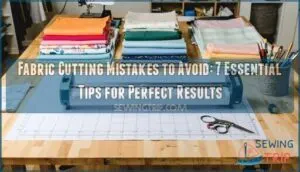This site is supported by our readers. We may earn a commission, at no cost to you, if you purchase through links.
 To clean a fabric dress form, start by vacuuming to remove loose dirt and debris. For the removable fabric cover, take it off and wash separately using appropriate cleaning solutions.
To clean a fabric dress form, start by vacuuming to remove loose dirt and debris. For the removable fabric cover, take it off and wash separately using appropriate cleaning solutions.
Mix Biz paste with water to brighten the outer layer, or use hydrogen peroxide in a spray bottle for stubborn stains. If using vinegar, wipe it off quickly to prevent damage.
For the base layer, steam clean carefully after vacuuming, then let everything dry completely before reassembling. Always handle your dress form gently and avoid harsh chemicals that could damage the construction materials.
The key is working systematically from outside to inside layers for best results.
Table Of Contents
- Key Takeaways
- Cleaning and Maintenance Tips
- Caution: Be Cautious When Cleaning to Avoid Damaging Construction Materials
- Vacuum First: Remove Loose Dirt Before Cleaning to Avoid Worsening Issues
- Linen Outer Cloth: Remove and Clean Separately Using Appropriate Solutions
- Biz Paste: Mix With a Little Water to Whiten The Outer Layer
- Hydrogen Peroxide: Use a Spray Bottle for Deep Stains, Shouldn’t Damage Linen
- Vinegar: if Used, Wipe Promptly to Prevent Damage, Avoid Organic and Filtered Versions
- Other Cleansers: Use Caution With Chlorine Bleach, Hydrogen Peroxide, and Dishwashing Liquid
- Cleaning a Vintage Dress Form
- Base Layer
- Recovering a Dress Form
- Benefits of Dress Forms
- Additional Tips for Dress Form Use
- Dress Forms Are Valuable Tools for Costume Technicians
- Keep Hands Clean While Working With Dress Forms
- Label Dress Forms With Your Name and Semester for Identification
- Move Dress Forms by The Metal Base to Prevent Damage
- Avoid Storing Pins in Dress Form Necks to Prevent Damage
- Don’t Lay Dress Forms Chest Side Down to Avoid Damage
- Do Not Remove Waist Stay Tape From Dress Forms
- Cover and Protect Dress Forms Before Craft Projects
- Switch Dress Forms if The Base is Broken and Doesn’t Adjust
- Check for Loose Parts and Notify Staff of Any Problems
- Avoid Using Heavy-duty Sticky Materials on Dress Forms
- Keep The Area Around Dress
- Frequently Asked Questions (FAQs)
- Conclusion
Key Takeaways
- Vacuum first, then work systematically – You’ll want to remove loose dirt and debris before applying any cleaning solutions to prevent grinding particles into the fabric during the cleaning process.
- Remove the fabric cover for separate cleaning – Take off the removable linen or fabric cover and wash it separately using mild detergent, hydrogen peroxide for stains, or Biz paste for whitening.
- Steam clean the base layer carefully – After vacuuming, you can steam clean the underlying structure, but you must let everything dry completely (24-48 hours) before reassembling to prevent mold and structural damage.
- Handle with care and avoid harsh chemicals – Move your dress form by the metal base only, don’t use chlorine bleach or let vinegar sit too long, and always test cleaning solutions on hidden areas first.
Cleaning and Maintenance Tips
Cleaning your fabric dress form properly keeps it looking great and extends its life.
You’ll need to be careful with your approach since these forms have delicate materials underneath that outer fabric layer, and properly cleaning them is essential to maintain their quality.
Caution: Be Cautious When Cleaning to Avoid Damaging Construction Materials
Before you begin dress form cleaning, think twice about your approach.
One careless move can turn your dress form into an expensive repair project.
Different construction materials require specific care to avoid costly damage.
- Check material vulnerability – Examine the outer fabric and underlying layers like paper mache or cotton batting
- Test cleaning solvents – Apply any cleaner to a hidden area first to prevent fabric damage or discoloration
- Consider layer sensitivity – Avoid saturating the form since moisture damage can weaken structural integrity
- Protect construction materials – Use gentle blotting motions rather than aggressive scrubbing techniques
Smart dress form care starts with understanding what you’re working with before applying any cleaning tips.
Vacuum First: Remove Loose Dirt Before Cleaning to Avoid Worsening Issues
Before you start your dress form cleaning routine, vacuum away loose dirt and debris. This prevents grinding particles into the fabric during cleaning.
Use vacuum attachments like soft bristle brushes for delicate areas and lint rollers for surface dust. You may need a specialized brush for this task.
| Tool | Best For | Technique |
|---|---|---|
| Soft brush attachment | Crevices and folds | Gentle circular motions |
| Lint roller | Surface dust removal | Light rolling strokes |
| Bristle brush | Stubborn debris | Quick whisking motions |
| Upholstery tool | Deep cleaning prep | Slow, methodical passes |
| Crevice tool | Tight spaces | Careful insertion |
This prep work prevents dust accumulation from becoming embedded stains and supports allergy prevention while keeping your dress form ready for detailed cleaning.
Linen Outer Cloth: Remove and Clean Separately Using Appropriate Solutions
Carefully removing linen from your dress form guarantees proper fabric cleaning without damaging the delicate internal structure.
Most professional forms feature removable linen covers secured with zippers or snaps.
- Linen removal: Check for hidden fastenings before gently detaching the cover
- Solution selection: Use mild detergent in lukewarm water below 104°F
- Gentle washing: Hand wash with minimal agitation, avoiding wringing or twisting.
For best results, follow the linen washing guidelines to maintain the fabric’s quality.
Biz Paste: Mix With a Little Water to Whiten The Outer Layer
Biz paste creates a whitening powerhouse when you mix the powder with warm water.
This DIY paste variation targets stubborn stains on your fabric dress form’s linen surface.
Apply the thick mixture directly to dingy areas, letting the enzyme blend work its magic for up to thirty minutes.
The paste’s whitening effectiveness comes from sodium percarbonate, which releases hydrogen peroxide naturally.
BIZ powder’s formula has moderate aquatic toxicity.
Always test linen compatibility first on a hidden spot before full application to ensure safe use.
Hydrogen Peroxide: Use a Spray Bottle for Deep Stains, Shouldn’t Damage Linen
When Biz paste doesn’t quite cut it, hydrogen peroxide becomes your secret weapon for tackling those stubborn stains on your fabric dress form.
This gentle yet powerful solution works wonders on linen without causing damage, making it perfect for deep cleaning your dress form’s outer cover.
- Peroxide Application: Spray directly onto stained areas using a standard spray bottle for even coverage
- Stain Removal: Works effectively on protein-based stains like blood, sweat, and organic matter
- Linen Safety: Won’t weaken or discolor white linen fibers like harsh bleaches can
Simply spray hydrogen peroxide onto the problem spots and let it work its magic for 10-15 minutes before blotting with a clean cloth.
The oxygen release breaks down stain molecules naturally, restoring your dress form’s appearance without compromising the linen’s integrity.
Vinegar: if Used, Wipe Promptly to Prevent Damage, Avoid Organic and Filtered Versions
White vinegar can tackle stubborn stains on your fabric dress form, but it’s not your friend if you let it linger.
Vinegar works fast, but letting it sit too long spells trouble for your dress form’s delicate fabric.
The acid in vinegar breaks down fabric fibers over time, so you’ll want to act fast with vinegar application and removal.
Always choose distilled white vinegar over organic and filtered versions – those fancy types contain dyes and particles that’ll stain your dress form.
Skip apple cider, balsamic, or flavored vinegars entirely, as they’re a recipe for disaster on light fabrics.
For vinegar dilution, mix equal parts water and vinegar before applying.
Spray lightly, then immediately blot with a clean cloth.
Don’t let vinegar residue sit around – it weakens linen and cotton covers.
Vinegar safety means testing on a hidden spot first and never mixing with bleach.
Consider vinegar alternatives like mild detergent or hydrogen peroxide for gentler mannequin cleaning.
Your dress form care routine should prioritize fabric preservation over aggressive stain removal, ensuring the longevity of your dress form.
Other Cleansers: Use Caution With Chlorine Bleach, Hydrogen Peroxide, and Dishwashing Liquid
When cleaning your fabric dress form, exercise extreme caution with harsh chemicals that can cause irreversible damage.
Chlorine bleach poses serious risks to linen fibers, potentially causing yellowing, weakening, and holes. Always test cleanser compatibility on hidden areas first.
- Bleach alternatives: Choose oxygen-based bleaches or hydrogen peroxide over chlorine bleach for safer whitening
- Peroxide dilutions: Use 3% hydrogen peroxide solutions and limit soaking to 10-30 minutes maximum
- Dish soap residue: Rinse thoroughly after using dishwashing liquid to prevent dirt-attracting buildup on your mannequin
Cleaning a Vintage Dress Form
Vintage dress forms need extra care since they’re often fragile and made from delicate materials. Start by checking what’s underneath the outer fabric – you might find paper mache, shredded paper, or other vulnerable materials that require special handling. Material identification helps you choose the right cleaning approach without causing damage.
When tackling vintage dress form stain removal, remove the outer linen layer first and hand-wash it separately using gentle cleaners like Woolite mixed with cold water. Use light circular motions to avoid tearing aged fabric. For stubborn stains, try hydrogen peroxide in a spray bottle – it won’t damage most linen covers.
Here’s what makes vintage restoration so rewarding:
- Preserving history – You’re saving a piece of fashion craftsmanship
- Creating heirloom pieces – Your restored form becomes a treasured tool
- Satisfying transformation – Watching something worn become beautiful again
If you discover shredded paper filling during cleaning, plan for paper replacement with cotton batting. Regular maintenance prevents future gunky messes. Address any rust removal needs on metal parts before cover preservation. Allow everything to air dry completely before reassembling your restored vintage fabric dress form.
Base Layer
Once you’ve tackled the surface cleaning, you’ll need to address what’s underneath that fabric cover.
Steam cleaning works well for the base layer, but you must let everything dry completely before putting your dress form back together.
Steam Clean Carefully After Vacuuming, Let Both Layers Dry Before Reassembly
After vacuuming your fabric dress form, steam cleaning removes deep-set dirt and stains effectively.
Use low steam temperature to prevent layer saturation, which can damage internal materials.
Allow complete drying time—typically 24-48 hours—before reassembly to avoid reassembly issues.
Proper drying prevents mold growth and maintains the form’s structural integrity for future use.
Replace Shredded Paper: Dispose or Use as a Fire Starter, Replace With Cotton Batting
Once both layers dry completely, you’re ready to tackle the dress form restoration project. Remove old shredded paper from your vintage dress form’s base layer – it won’t go in curbside recycling, but you can repurpose it creatively.
Replace the outdated filling with cotton batting for better material safety and durability. Cotton batting won’t settle like shredded paper, keeping your dress form stable longer.
Here’s your step-by-step approach:
- Remove shredded paper carefully – wear gloves to avoid cuts from sharp edges
- Create fire starters – mix paper with wax at 2:1 ratio for eco-friendly disposal
- Choose cotton batting – select polyester or cotton sheets for easy shaping
- Layer batting strategically – build volume to match body contours accurately
- Secure new filling – pin batting in place before reassembling your fabric dress form
You can even find a suitable batting dress for inspiration. This upgrade transforms your vintage restoration project into a reliable sewing tool that’ll serve you well for years.
Recovering a Dress Form
When recovering a dress form, you’ll transform its appearance with fresh fabric.
Purchase ready-made covers or create handmade covers using jersey material for affordable solutions.
Jersey material doesn’t need hemming, making pattern selection simpler.
Custom body measurements guarantee a perfect fit.
Customizing covers lets you match your workspace aesthetic while completing dress form restoration projects easily.
Benefits of Dress Forms
After you’ve thoroughly cleaned your dress form, you’ll discover why these tools are essential for any sewing enthusiast.
They save you countless hours during fitting sessions, keep your measurements private, and make clothing alterations much easier to handle.
Time-saving Tool
A dress form becomes your personal sewing assistant, eliminating countless hours of tedious fitting sessions.
Instead of constantly trying on half-finished garments, you’ll streamline your entire sewing process through efficient pinning and quick alterations directly on the mannequin.
- Efficient pinning – Pin seams and hems without awkward contortions
- Quick alterations – Make adjustments instantly without multiple fittings
- Streamlined draping – Test fabric flow and fit before cutting patterns
Maintains Secret Measurements
Your dress form protects client measurements better than a locked vault.
Once you’ve cleaned and maintained your mannequin, it becomes a trusted keeper of sensitive sizing information.
| Privacy Feature | Benefit | Professional Impact |
|---|---|---|
| Accurate Sizing | Eliminates measurement errors | Builds client trust |
| Consistent Fit | Repeatable garment results | Reduces costly remakes |
| Design Confidentiality | Protects custom measurements | Maintains professional reputation |
| Client Privacy | Secures personal dimensions | Guarantees discretion |
| Pattern Precision | Exact fit every time | Delivers quality work |
Assists in Clothing Alterations
Precision becomes your best friend when fitting adjustments require exact measurements.
A clean fabric dress form provides the stable foundation you need for alteration precision, allowing you to pin, measure, and refine garments with consistent accuracy.
Design refinement flows naturally when your dress form maintains its shape, supporting posture correction and symmetry improvement throughout the alteration process.
Additional Tips for Dress Form Use
Beyond cleaning, you’ll need to follow some important handling practices to keep your dress form in top condition.
These simple guidelines will help you avoid costly damage and extend your form’s lifespan substantially.
Dress Forms Are Valuable Tools for Costume Technicians
Beyond their obvious benefits for fitting and altering garments, dress forms serve as indispensable tools for costume technicians who demand Professional Results.
These versatile assistants enable precise Fabric Selection and Accurate Draping techniques that transform creative visions into reality.
- Form Customization – Adjust measurements for character-specific requirements
- Fabric cleaning guide – Maintain pristine surfaces for professional work
- Cleaning techniques – Preserve form integrity during intensive use
- Mannequin maintenance – Regular care prevents costly replacements
- Costume Technicians Assistant – Streamline workflow and improve efficiency
Keep Hands Clean While Working With Dress Forms
Clean hands are essential for proper dress form care and mannequin maintenance. Always wash thoroughly before handling to prevent stains and protect material sensitivity.
Oil and dirt from your skin can damage delicate fabrics permanently. Consider wearing gloves when working with cleaning supplies or handling vintage forms.
This simple hand hygiene step guarantees your dress form stays pristine. Always prioritizing proper dress form care is crucial for maintaining the quality and longevity of your dress form.
Label Dress Forms With Your Name and Semester for Identification
Everyone wants to keep track of their dress form in shared spaces like studios or classrooms.
Proper labeling prevents mix-ups and guarantees you can locate your equipment when cleaning fabric or removing stains from accumulated dirt.
- Use waterproof permanent markers or adhesive labels that won’t fade
- Write your full name and current semester clearly on the neck area
- Include contact information like phone number or email address
- Choose inconspicuous spots that won’t interfere with your sewing work
- Update labels each semester to maintain accurate form responsibility records
The identification benefits extend beyond simple ownership – you’ll avoid the frustration of searching through dozens of identical forms.
Smart labeling methods make semester tracking effortless while preventing loss in busy environments.
Move Dress Forms by The Metal Base to Prevent Damage
Always grab your dress form by its metal base when moving it around your workspace.
This proper handling technique protects the fabric surface and maintains base stability during transport.
The metal base provides the strongest grip point and prevents damage to delicate fabric areas.
Avoid lifting by the torso or shoulders, which can compromise the form’s structural integrity and tear the outer covering, to ensure proper handling.
Avoid Storing Pins in Dress Form Necks to Prevent Damage
When storing pins during dress form cleaning, avoid placing them in the neck area to prevent fabric damage and stains.
The delicate neck material can tear or develop rust marks from metal pins.
- Use a magnetic pin holder – Keeps pins organized and prevents neck damage risks
- Try a traditional pin cushion – Portable option that protects your dress form’s fabric
- Consider a small jar or container – Safe pinning practices that extend form longevity
Repairing neck damage costs more than prevention, so establish proper pin storage alternatives from the start.
Don’t Lay Dress Forms Chest Side Down to Avoid Damage
Never position your dress form chest-side down during storage or cleaning.
This placement creates uneven weight distribution on the internal structure, potentially causing material degradation and compromising form stability.
The chest area bears concentrated pressure that can flatten curves and damage delicate fabric surfaces.
Always store your dress form upright or on its side to prevent chest damage and maintain its shape for future sewing projects, ensuring the form’s internal structure remains intact and preserving its overall stability.
Do Not Remove Waist Stay Tape From Dress Forms
Most dress forms have waist stay tape that serves as the backbone of their structural integrity.
This tape isn’t decorative—it’s essential for maintaining the form’s shape during cleaning and daily use.
Removing it compromises the entire structure, making restoration nearly impossible.
Focus your cleaning efforts on stain removal and fabric maintenance while preserving this critical component for long-term dress form maintenance.
Consider adjustable dress forms for a more customized fit.
Cover and Protect Dress Forms Before Craft Projects
Smart crafters know that prevention beats restoration every time. Before starting any messy project, you’ll want to shield your dress form from potential damage.
Fabric Protection starts with choosing the right Temporary Shields for your specific craft needs.
- Plastic Wrap creates a waterproof barrier for paint or dye projects
- Fitted Covers made from old sheets protect during sewing alterations
- Padded Layers of newspaper work well for light dust protection
- Drop cloths taped at edges prevent drips from reaching fabric surfaces
- Trash bags offer quick coverage for unexpected stains during rushed projects
Switch Dress Forms if The Base is Broken and Doesn’t Adjust
A wobbly adjustment mechanism can turn your dress form into a frustrating obstacle.
When the base fails to hold steady heights or won’t lock properly, it’s time for Base Alternatives rather than wrestling with Repair Difficulty.
Swap out the unreliable unit for one with proper Form Stability.
This simple switch eliminates Adjustment Issues and proves more cost-effective than extensive repairs through basic Cost Analysis.
Check for Loose Parts and Notify Staff of Any Problems
Looking beyond base adjustments, regular form inspections prevent bigger problems down the road.
Smart cleaning starts with checking your dress form’s overall condition before diving into fabric care.
Before each use, examine your dress form for potential issues that could worsen during cleaning:
- Check fabric cover – Look for tears, loose seams, or worn spots that need repair
- Test base stability – Make sure the stand doesn’t wobble or have loose screws
- Inspect padding attachment – Verify stuffing stays put and doesn’t shift around
- Scan for sharp objects – Remove any pins, needles, or fasteners left behind
- Assess adjustment mechanisms – Make sure height and size controls work smoothly
These routine inspections catch damage early, preventing costly repairs later.
When you spot loose parts or wear, report issues immediately to whoever maintains your forms.
This keeps everyone’s dress forms safe and functional for years of creative projects.
Avoid Using Heavy-duty Sticky Materials on Dress Forms
Heavy-duty adhesives can leave stubborn adhesive residue and cause material degradation on your dress form.
These sticky substances create cleaning challenges that may lead to permanent fabric damage. Instead of tape or strong adhesives, try pin alternatives like removable clips or gentle marking tools.
When you must use adhesives, test them first on a hidden area.
Protect your dress form with removable fabric covers during messy projects. This prevents stains and grime removal headaches later, and helps maintain the form’s quality by avoiding the need for difficult cleaning challenges.
Keep The Area Around Dress
Keep your workspace organized around your dress form to prevent accidents and maintain efficiency.
Clear pathways reduce tripping hazards while working on projects.
Store cleaning supplies, tools, and equipment in designated spots for easy access.
Good lighting setup helps you spot dirt and stains quickly.
Dust prevention starts with organized tool placement and spill control measures in your sewing area, and maintaining a clean workspace is crucial for easy access to your tools and equipment.
Frequently Asked Questions (FAQs)
How to clean a vintage mannequin?
Before cell phones ruled the world, you’d vacuum your vintage mannequin first, then spot-clean with mild detergent and warm water.
Check what’s underneath the fabric—paper mache needs gentler care than solid forms.
Let it dry completely.
How to clean formal dresses at home?
Check the care label first, then hand wash delicate gowns in cool water with gentle detergent.
Steam or professionally press structured pieces.
Air dry flat to prevent stretching and maintain shape.
How to clean a dress that cannot be dry cleaned?
Delicate dresses demand different approaches.
Hand-wash gently using cold water and mild detergent.
Lay flat to dry, avoiding direct sunlight.
Test cleaning solutions on hidden areas first to prevent damage or discoloration.
How to clean a fabric doll?
Gently vacuum your fabric doll to remove dust and debris.
Spot clean stains with mild detergent and water, blotting carefully.
Avoid soaking the doll completely, as this can damage internal stuffing materials.
Can you clean dress forms with steam cleaners?
Steam cleaners can clean fabric dress forms, but use caution.
You’ll want to test a small area first and avoid oversaturating the fabric to prevent damage to underlying materials like paper mache or fillings inside.
How often should dress forms be deep cleaned?
How often should you tackle a thorough deep clean? Deep clean your fabric dress form every 3-6 months, depending on usage frequency and dust accumulation in your sewing space.
What cleaning products damage dress form padding?
Vinegar, bleach, and harsh chemicals can damage paper mache padding inside dress forms. Avoid soaking cleaners that penetrate the outer fabric and reach vulnerable inner materials like shredded paper fillings.
Can you machine wash removable dress form covers?
Yes, you can machine wash removable dress form covers if they’re made from washable fabrics like linen or cotton.
Check the care label first, then use gentle cycle with cold water and mild detergent to prevent shrinkage, this includes following the instructions carefully to ensure the fabric is not damaged.
How do you clean dress form adjustment mechanisms?
Like delicate clockwork needing gentle care, you’ll want to use a dry brush or compressed air to remove dust from adjustment knobs and mechanisms.
Avoid moisture completely—it’ll cause rust and damage moving parts, which is a critical consideration for maintaining delicate mechanisms.
Conclusion
Your dress form stands as a faithful companion in your creative journey, deserving proper care to serve you well.
Regular maintenance protects this valuable tool from wear and damage. Remember that knowing how to clean a fabric dress form properly extends its lifespan substantially.
Start with gentle vacuuming, then work systematically through each layer. Use appropriate cleaning solutions for different materials, but always test first.
Handle with care during cleaning and storage. With consistent attention, your dress form will remain a reliable partner for countless sewing projects ahead.











